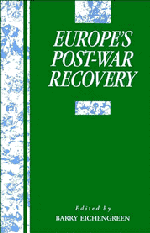Book contents
- Frontmatter
- Contents
- List of contributors
- Preface
- Part I Introduction and survey
- Part II The Marshall Plan
- 2 The Marshall Plan reconsidered
- 3 Influencing aid recipients: Marshall Plan lessons for contemporary aid donors
- Part III Other international initiatives
- Part IV Country studies
- Part V Synthesis
- Index
3 - Influencing aid recipients: Marshall Plan lessons for contemporary aid donors
Published online by Cambridge University Press: 07 September 2010
- Frontmatter
- Contents
- List of contributors
- Preface
- Part I Introduction and survey
- Part II The Marshall Plan
- 2 The Marshall Plan reconsidered
- 3 Influencing aid recipients: Marshall Plan lessons for contemporary aid donors
- Part III Other international initiatives
- Part IV Country studies
- Part V Synthesis
- Index
Summary
Today, at the end of the Cold War and with the collapse of communism, the Eastern European and ex-Soviet economies find themselves in an economic quandary no less formidable than that of Western Europe after World War II. While Eastern Europe and the former Soviet Union did not undergo the large-scale physical destruction wrought by World War II, they are beset by another predicament perhaps more difficult to overcome, namely the lack of entrepreneurial skills and institutional frameworks required in a capitalist system. Moreover, Western European economic recovery and democratic stabilization, it can be argued, was greatly aided by the external funding of the Marshall Plan. No such aid package has yet been offered to the struggling Eastern economies. But it is quite important to define just what was the role played by the massive American aid package in achieving Western Europe's recovery.
As we shall see the Marshall Plan was conceived as a panacea for all of Western Europe's immediate and long-term problems. But did the Americans succeed in achieving their goals? This chapter will argue that while Marshall aid was not a success in terms of achieving specific economic goals, it did attain its political aims. These conclusions will be reached through an analysis of two key areas of Marshall Plan operations. First, we shall recount how, at the Europe-wide level, the United States sought to influence the creation of an intra-European payments system. Second, we shall examine the impact of conditional Marshall aid funding in France and Italy.
- Type
- Chapter
- Information
- Europe's Postwar Recovery , pp. 68 - 90Publisher: Cambridge University PressPrint publication year: 1995
- 2
- Cited by



